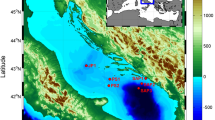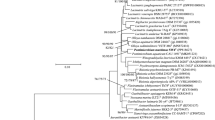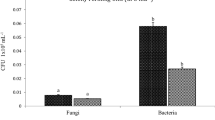Abstract
IT is the experience of most microbiologists that the differentiation of the non-pathogenic, asporogenous, non-pigmented rods is of considerable difficulty. These bacilli form an appreciable part of the air–soil–water microflora and, in materials from marine environments, such as fish, in which our interests are focused, they comprise 60–80 per cent of the total number of species isolated1. The main difficulty is that, by the usual tests, most of these micro-organisms appear to be biochemically inert, and the classification, based on a series of negative characters, is not very determinative. The types of organism we have in mind are usually classified among the Pseudomonadaceae, Achromobacteriaceae and Bacteriaceae of Bergey2 and Prévot3. In Bergey, the Pseudomonadaceae comprises, among others, the genera Pseudomonas, Vibrio and Spirilla, and the Achromobacteriaceae the genera Achromobacter and Flavobacterium. In Prévot, however, the Vibrios are removed from the Pseudomonadaceae and form a genus of the Spirillales, while the Achromobacter and Flavobacterium become genera of the Pseudomonadaceae. Comparison with a recent Russian determinative system4 shows even wider divergences, the Achromobacteriaceae disappearing altogether, being grouped as Bacterium spp. under the Bacteriaceae.
This is a preview of subscription content, access via your institution
Access options
Subscribe to this journal
Receive 51 print issues and online access
$199.00 per year
only $3.90 per issue
Buy this article
- Purchase on SpringerLink
- Instant access to full article PDF
Prices may be subject to local taxes which are calculated during checkout
Similar content being viewed by others
References
Shewan, J. M., J. Roy. San. Inst., 69, 394 (1949).
Breed, R. S., Murray, E. G. D., and Hitchins, A. P., “Bergey's Manual of Determinative Bacteriology”, 6th edit. (Williams and Wilkins Co., 1948).
Prévot, A. R., “Manuel de Classification et Determination des Bactéries Anaérobies”, Mon. Inst. Past. (1948).
Krasil'nikov, N. A., “Determination of Bacteria and Actinomyces”, Acad. Sci. U.S.S.R., Instit. Microbiology, Moscow-Leningrad (1949).
Collier, H. O. J., Campbell, N. R., and Fitzgerald, M. E. N., Nature, 165, 1004 (1950).
Rep. Chem. Res. Bd., Lond., 1951, pp. 97–112.
Gaby, W. L., and Free, E., J. Bact., 65, 746 (1953).
Liston, J. (unpublished results, Torry Research Station, Aberdeen).
Author information
Authors and Affiliations
Rights and permissions
About this article
Cite this article
SHEWAN, J., HODGKISS, W. & LISTON, J. A Method for the Rapid Differentiation of Certain Non-pathogenic, Asporogenous Bacilli. Nature 173, 208–209 (1954). https://doi.org/10.1038/173208b0
Issue date:
DOI: https://doi.org/10.1038/173208b0
This article is cited by
-
Pseudomonas halodurans sp. nov., a halotolerant bacterium
Archives of Microbiology (1983)
-
Ecology and taxonomy of chitinoclasticCytophaga and related chitin-degrading bacteria isolated from an estuary
Microbial Ecology (1983)
-
Vibrio ordalii sp. nov.: A causative agent of vibriosis in fish
Current Microbiology (1981)
-
Microbial associations in sponges. II. Numerical analysis of sponge and water bacterial populations
Marine Biology (1978)
-
Characterization of some fish and shrimp spoiling bacteria
Antonie van Leeuwenhoek (1977)



